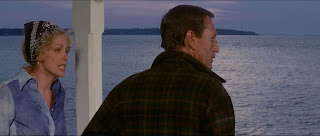The expanse of water behind him is softened by the glow of the setting sun, and it looks as inviting as it most probably did to Chrissie when she went for her midnight swim. The cutaway shot of the two Brody boys (Michael in his boat, Sean on the jetty) seems to isolate them in a chillier environment, with no evidence of the honeyed sunlight on the cold grey water. Ellen, still holding the shark book in her hand, joins her husband on the porch, and immediately takes the son's side against the father's authority. Just as in the earlier kitchen scene, when Ellen's casual remark whilst cleaning Michael's cut hand ('I think you're going to live') prefigures her son's close encounter with the shark, so too her comment here ('I don't think he'll ever go in the water again after what happened yesterday') points unwittingly towards the attack in the estuary.
Brody tries the erase the image his wife has conjured up ('Alright, now don't say that.'). Clearly, what's he's referring to here ('I don't want that to happen, you know that.') is the attack he witnessed on Alex Kintner, a boy about the same age as his elder son - a surrogate child for whose death he feels responsible. This sense of responsibility is linked to what he sees as his failure to ensure public safety, and is made explicit here by his reference to the fact that he wants Michael 'to read the boating regulations- the rules.' He believes that rules -like fences - are there to help keep order.
Ellen glances down at the open book in her hands and there is a cut to an illustration of a shark attacking two fishermen in a rowing boat. The camera focuses first on the shark's jaws chewing a hole in the wooden hull and then pans upwards to show the reaction of the fishermen. It's this image that makes Ellen realise how real and indeed how close the threat is, and results in her sudden volte-face, yelling at her child to listen to his father. The image also has visual echoes later in the film: the two men on the dock who try to catch the shark with the bait of a holiday roast, the hole in Ben Gardner's boat, the estuary victim's rowing boat, and the shark's final assault on the Orca are all in some sense visually prefigured in the book illustration. It also, unintentionally, anticipates the main narrative of Jaws 2, in which a number of boats are holed by a Great White.
The picture itself looks like a magazine illustration, and it's closer to comic book art than high art. There is, in fact, a rather similar painting by eighteenth century American artist John Singleton Copley called Watson and the Shark, which was based on the first fully documented account of a shark attack on a swimmer.


